How To Make Skin Color With Acrylic Paint
An Easy Method for Mixing Pare Tones with Acrylic Pigment
 By using the simple method detailed in this tutorial, you'll learn how to mix skin tones using unlike ratios of the primary colors. This easy method requires a picayune work to refine, simply information technology is a fantastic and attainable method for artists of any level. With a little exercise, you'll be creating peel tones like a pro.
By using the simple method detailed in this tutorial, you'll learn how to mix skin tones using unlike ratios of the primary colors. This easy method requires a picayune work to refine, simply information technology is a fantastic and attainable method for artists of any level. With a little exercise, you'll be creating peel tones like a pro. Getting Started with Skin Tones
Determining Skin Color
The colors yous select depend a cracking deal on the skin tone of the person you are painting. While on one level it is easy to make up one's mind if the skin is dark, medium or light, you'll besides need to consider the undertones of the skin. For example, you might not think of many skin tones every bit containing the colour blue, but many do, to some degree. By really looking at the tone y'all're trying to attain, you can brand informed decisions about creating a skin tone in acrylic paint.Creating a Family of Tones
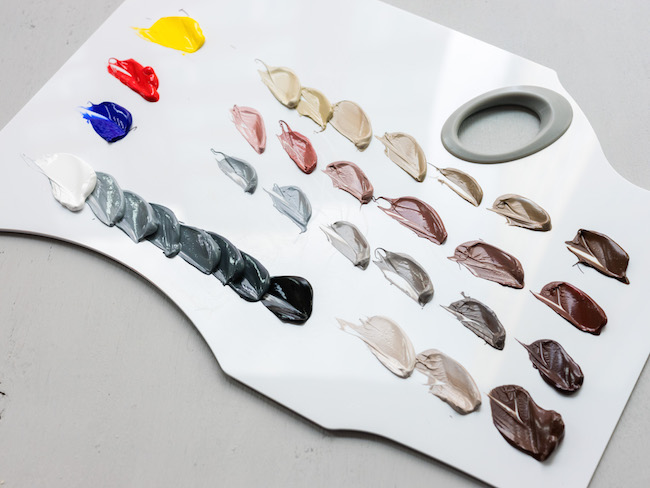 Information technology's good to create a "family unit" of tones around your chosen skin tone so that you can add accents. As yous can meet here, the same skin tone is mixed with a petty bit of blue, yellow and red in each spot of color. Save these emphasis colors for attaining details on the skin.
Information technology's good to create a "family unit" of tones around your chosen skin tone so that you can add accents. As yous can meet here, the same skin tone is mixed with a petty bit of blue, yellow and red in each spot of color. Save these emphasis colors for attaining details on the skin. Tips for Mixing Acrylic Pigment
- Acrylic paint looks a little bit darker dry than when information technology is wet. Then make the paint colour slightly lighter than you lot'd like the final outcome to be.
- It can be tough to mix a specific colour using acrylic pigment, so if you are looking for the perfect tone for a big slice or an ongoing series, brand notes of the colors that went into the mixture. Better nonetheless, mix up a large batch of the tone in question so that y'all volition accept plenty on hand.
- While white paint is helpful to achieve skin tones, apply black paint very sparingly. Black pigment can react with the yellow in skin tones to create a light-green, muddy wait. If you lot need to make a skin tone darker, use a modest amount of each primary color in equal quantity rather than adding black paint to the mix.
How to Paint Skin Tones in Acrylic
Stride one:
Create a palette with the primary colors: yellow, blue, red. White and black are optional. Have a photograph or reference prototype handy for the tone y'all are trying to achieve.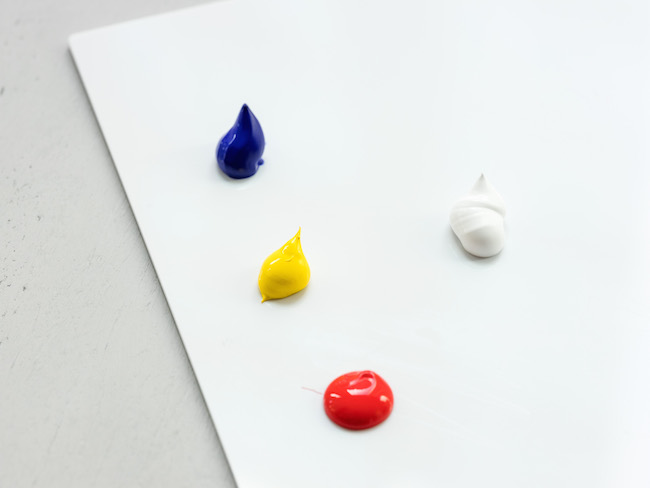 Annotation: Call up to be very sparing with black pigment.
Annotation: Call up to be very sparing with black pigment. Stride 2:
Mix together equal parts of each primary color.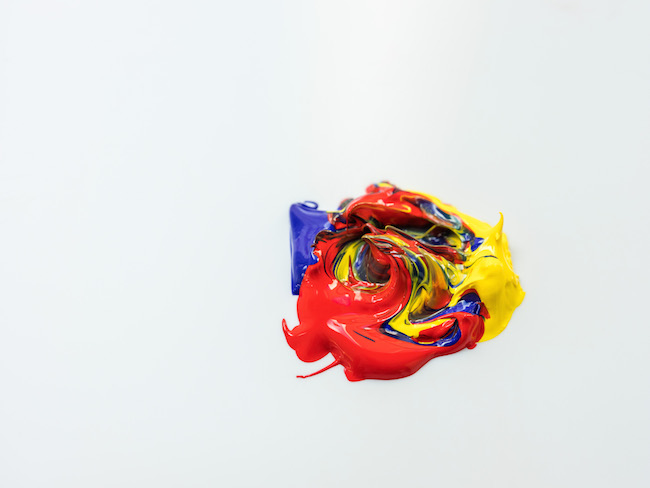
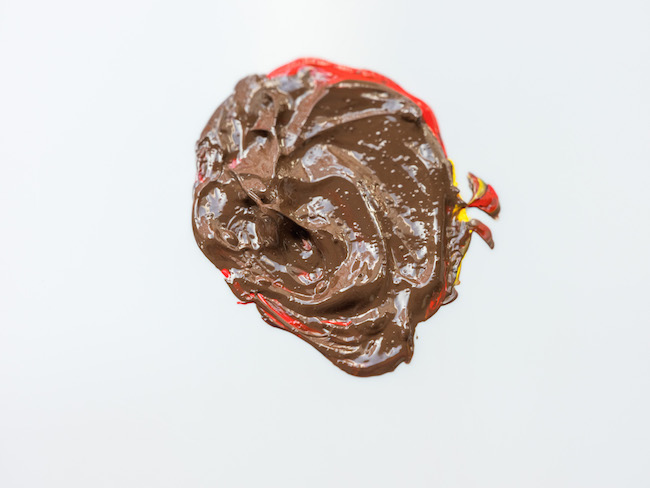 Just about every peel tone contains a picayune yellowish, blue and scarlet, but in dissimilar ratios. Once you've washed this a few times, you might first with more than of one color or another. But to start, go ahead and mix equal parts of each color with a palette pocketknife. Your outcome will likely be somewhat dark. This is a adept thing, considering in general, it's easier to make peel tones lighter with acrylic than darker.
Just about every peel tone contains a picayune yellowish, blue and scarlet, but in dissimilar ratios. Once you've washed this a few times, you might first with more than of one color or another. But to start, go ahead and mix equal parts of each color with a palette pocketknife. Your outcome will likely be somewhat dark. This is a adept thing, considering in general, it's easier to make peel tones lighter with acrylic than darker. Step 3:
Now, it'south fourth dimension to refine your color. Every bit noted above, if y'all've mixed equal parts of each color, the blue in detail has probably made the color mix quite dark. Initial adjustments volition be clear: if you demand to make the pare lighter, add white and/or yellow. If y'all need to make it more red, add more red.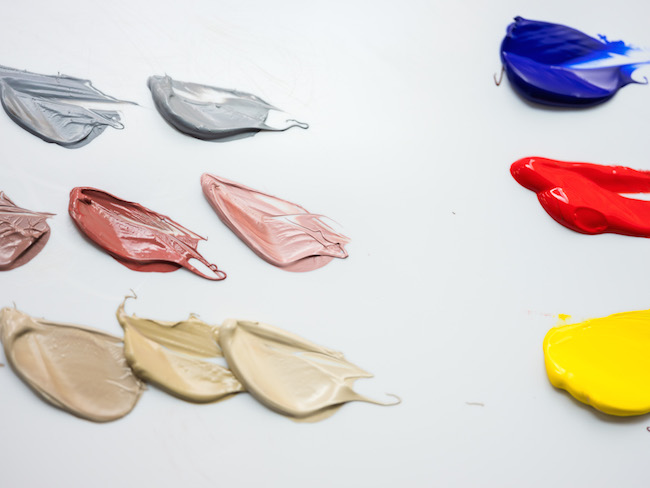 Once you brand these obvious tweaks, you'll accept the opportunity to refine, adding a little scrap of this color, a lilliputian bit of that, until you've attained the exact tone you're looking for. All of the beneath peel tones were attained by making refinements to the initial master color mix.
Once you brand these obvious tweaks, you'll accept the opportunity to refine, adding a little scrap of this color, a lilliputian bit of that, until you've attained the exact tone you're looking for. All of the beneath peel tones were attained by making refinements to the initial master color mix. Advanced for Painting Flesh Tones
One time you've mastered this method of creating peel tones, y'all can set yourself up like a professional painter.Mix Shadows and Highlights
Once you've gotten the verbal correct skin tone, create a "family unit" of tones effectually your chosen tone. This is a time when you can employ black pigment to your advantage. Mix a gradient of variations on your final peel tone with blackness or white paint so that yous have paint in various related tones ready to create shadows or highlights in your work.Blush Tones
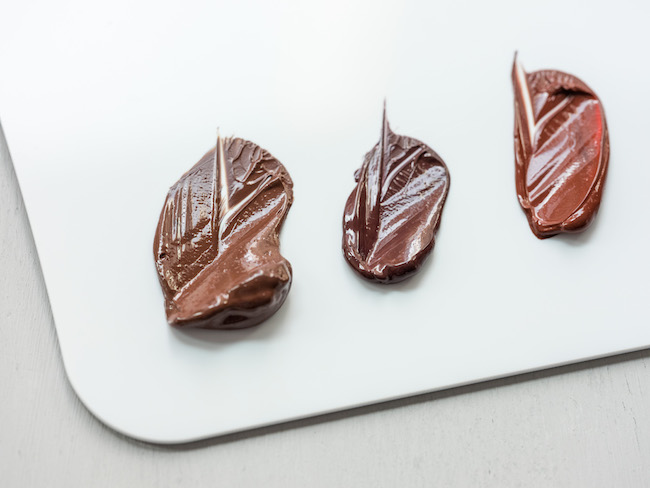 If you desire to create a chroma tone for your peel, don't simply utilise pinkish or red pigment on top of your skin tone. Create a custom tone by creating a mixture of your skin tone plus red for a color that volition expect natural as a "blush" tone.
If you desire to create a chroma tone for your peel, don't simply utilise pinkish or red pigment on top of your skin tone. Create a custom tone by creating a mixture of your skin tone plus red for a color that volition expect natural as a "blush" tone. Painting Skin Tones in Tinted Low-cal
Take the above concept a step farther and create a mixture of the skin tone with each of the principal colors. While some of them might look funny on the palette, the fact is that skin you are painting may reflect the colors of the painting'due south scene.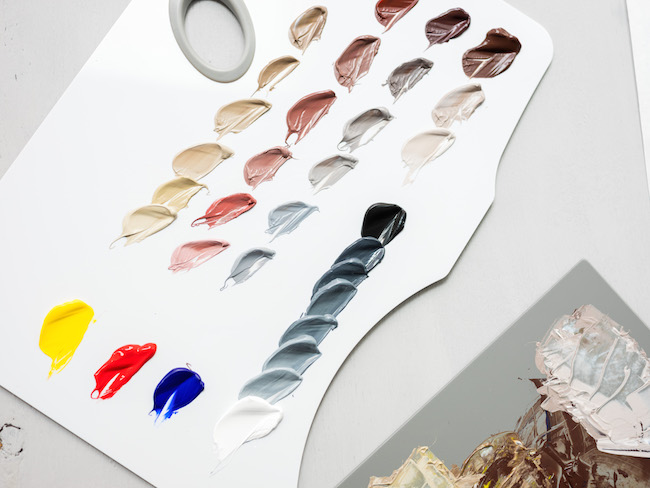 For example, if a character is standing near blue drapes, a sliver of blueish may announced on the highlights or shadows on the skin. By creating these variations, y'all'll be able to capture these details, which will make your terminal painting more lifelike.
For example, if a character is standing near blue drapes, a sliver of blueish may announced on the highlights or shadows on the skin. By creating these variations, y'all'll be able to capture these details, which will make your terminal painting more lifelike. Source: https://www.craftsy.com/post/mixing-paint-skin-tones/
Posted by: gardnerthems1979.blogspot.com


0 Response to "How To Make Skin Color With Acrylic Paint"
Post a Comment